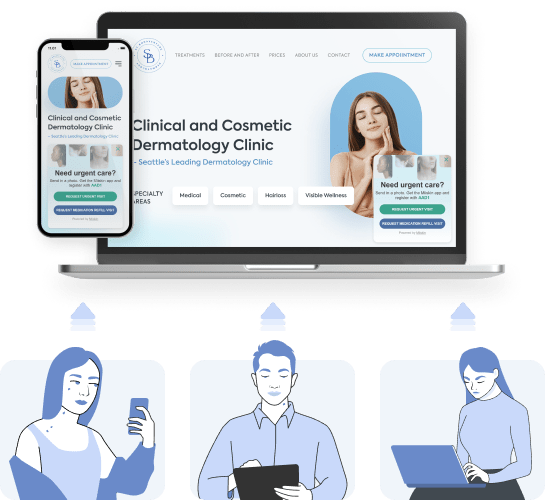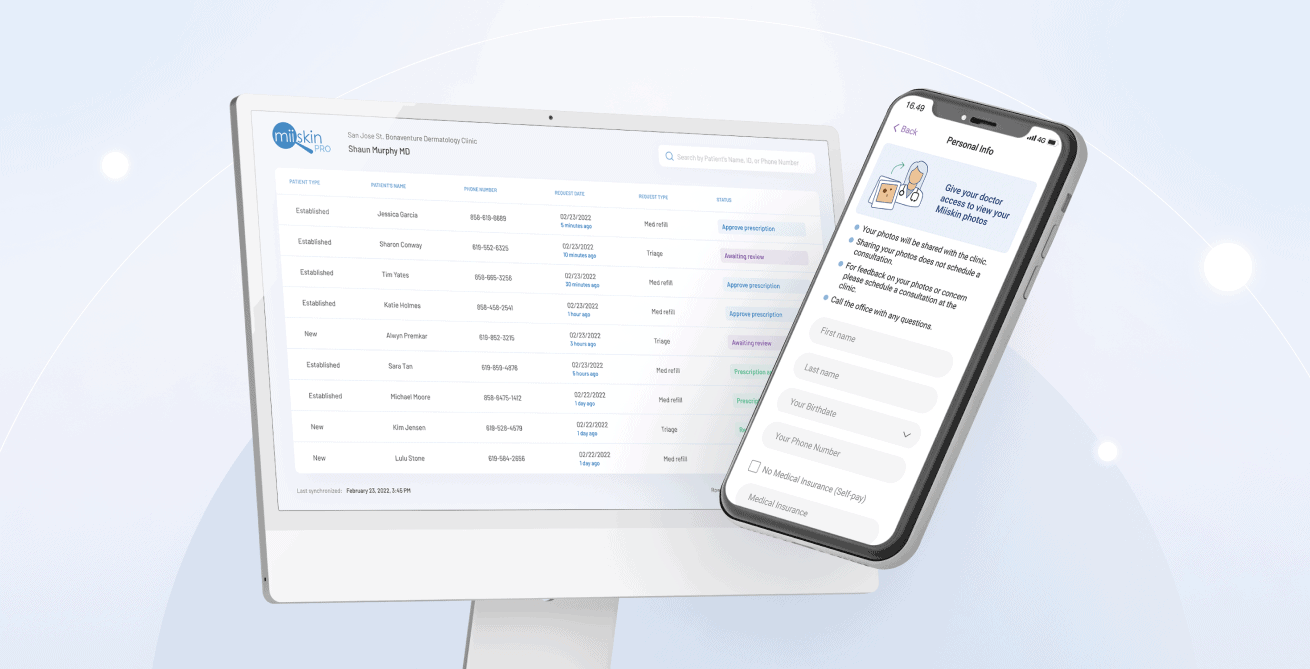How store and forward telehealth supports direct-to-consumer healthcare
Learn more about what store and forward telehealth is, how is impacting direct-to-consumer healthcare, and its benefits for healthcare providers and patients.
Table of Content:
What is store and forward telehealth? | Benefits | In which medical specialties is it used? | The business case for dermatologists | What derms say about the Miiskin network | Patient demand | Offering consultations via Miiskin | Get started | FAQ
In recent years, store and forward telehealth (also known as asynchronous telemedicine) has rapidly emerged as the new face of direct-to-consumer (DTC) healthcare, offering patients unprecedented convenience, accessibility, and efficiency by removing the need for live consultations.
Instead of scheduling real-time video or in-person appointments, patients can submit health information, images, or complete medical questionnaires through secure platforms and receive a diagnosis, treatment plan, or prescription from a licensed provider at a later time.
This flexible, patient-driven model is gaining significant momentum as companies like Miiskin, Curology, Nurx, Hers, and Hims challenge traditional healthcare delivery systems.
These companies facilitate the treatment of common health problems that can be effectively managed with asynchronous care—such as skin conditions, reproductive health, sexually transmitted diseases, and routine medication management—delivering services faster and often at a lower cost.
By cutting out intermediaries, streamlining access to specialists, and leveraging user-friendly digital tools, they are democratizing healthcare and appealing to a tech-savvy generation that values privacy, speed, and control over their health journey. As this trend continues to grow, store-and-forward telehealth is not only redefining the direct-to-consumer experience but also reshaping expectations around how and when care should be delivered.
So, what is store and forward telehealth?
Store and forward telehealth is a type of telemedicine that involves collecting and securely storing medical information—such as images, videos, lab reports, or patient data—and then sending it electronically to a healthcare provider for evaluation at a later time. This process does not require that the patient and provider be present simultaneously.
Key features of store and forward telehealth:
- Asynchronous review – Patient data is submitted and reviewed on your schedule, enabling flexible, efficient workflows.
- Clinical data focused – Ideal for specialties that rely on images and records, such as dermatology, radiology, pathology, and primary care.
- Secure & compliant – All information is encrypted and transmitted in accordance with HIPAA and other privacy regulation
FOR DERMATOLOGISTS IN USA
Want a steady stream of new patients every month?
Partner with Miiskin and start receiving a steady stream of new patients — simply by joining the platform!
✅ You must have a private practice
✅ You must have your own malpractice insurance (we can help you set-up one)
There’s no upfront subscription — just a $10 usage fee.
Boost your revenue starting today!
Benefits of store and forward telehealth
Benefits of asynchronous telemedicine for healthcare providers
- Scalable care – Manage more patients without overload.
- More flexibility– Review cases on your own schedule.
- Reduced burnout – Less pressure from real-time consults.
- Wider reach – Serve patients beyond your local area.
- Efficient triage – Prioritize in-person visits for complex cases.
- Easier collaboration – Seamless referrals and second opinions.
Benefits of asynchronous telemedicine for patients
- Access to specialists – No need to travel; care from remote experts.
- Convenient – Get access to care 24/7.
- Faster care – Quicker diagnosis and treatment.
- Lower costs – Fewer visits and travel expenses.
- More privacy – Discreet care for sensitive issues.
- Ongoing support – Easier follow-up and chronic care.
In which medical specialties is store and forward telemedicine recommended?
Dermatology is by far the most common and effective use case for store and forward telehealth, thanks to its reliance on high-quality images and visual diagnosis.
While other specialties can and do use store-and-forward models — such as radiology, ophthalmology, pathology, wound care, and dentistry — their use is more dependent on specific workflows or institutional setups (e.g., hospital systems or labs).
In contrast, direct-to-consumer telehealth platforms (like Miiskin, Curolology, and Nurx) primarily rely on this model in dermatology, men and women’s health, sexual health and medication refills where patients answer a clinical questionnaire for asynchronous review by a clinician.
So, in practical, widespread usage—especially in the DTC space—store-and-forward is predominantly used in dermatology.
The business case for dermatologists: Turn convenience into revenue
Asynchronous telemedicine care isn’t just clinically effective—it’s a smart business move. For dermatologists, store-and-forward telehealth provides a way to treat more patients with less administrative overhead. With Miiskin, you can unlock new revenue streams without increasing your clinic hours or hiring more staff. By reviewing cases on your own time, you make each minute more productive and more profitable.
Why it matters to your practice:
- Convert downtime into billable care
- Reduce no-shows and scheduling gaps
- Keep overhead low while increasing patient volume
- Compete with DTC brands by offering the same convenience—under your name
Real results: What dermatologists are saying about the joining Miiskin network
Miiskin is already helping dermatologists in the U.S. modernize their practices and grow their patient base with ease.
“Miiskin has connected me with thousands of patients, allowing me to deliver high-quality asynchronous care at scale. Whether patients are in rural areas or large cities, I can treat them efficiently without the limitations of a fixed schedule. This flexibility not only improves my workflow but also drastically reduces wait times for patients. Miiskin makes dermatology more accessible, efficient, and truly patient-centered.”
— Dr. Anna Chacon, Board-Certified Dermatologist, with license in all 50 states.
“What drew me to join the Miiskin network wasn’t just the technology — it was the way it understands the way dermatologists actually work. Asynchronous teledermatology gives me the flexibility to review cases on my own time. The platform is intuitive, secure, and purpose-built for dermatology, which means I’m not wasting time adapting to a generic system. Miiskin supports real continuity of care — I can monitor patients’ progress over time, respond quickly when needed, and maintain a level of efficiency that just isn’t possible in a traditional in-office setup. It’s a smarter way to practice.”
— Dr. Ryan Trowbridge, Board-Certified Dermatologist with license in CA, CT, NE and IL.
Patient demand for asynchronous telemedicine via Miiskin
Each year, thousands of patients turn to Miiskin looking for fast, expert care from a dermatologist. These are motivated, tech-savvy patients who prefer online consults over long wait times and travel. By joining the Miiskin network, you’re placed directly in front of this growing audience—and can accept as many or as few new patients as you like.
Demand snapshot:
- Thousands of patients use Miiskin annually to demand asynchronous dermatology care
- Collectively, the dermatologists in the Miiskin network have conducted over 50,000 consultations online
- 30% of Miiskin patients are repeat customers
FOR DERMATOLOGISTS IN USA
Want a steady stream of new patients every month?
Partner with Miiskin and start receiving a steady stream of new patients — simply by joining the platform!
✅ You must have a private practice
✅ You must have your own malpractice insurance (we can help you set-up one)
There’s no upfront subscription — just a $10 usage fee.
Boost your revenue starting today!
Offering asynchronous telemedicine consultations via Miiskin fits into your workflow seamlessly
The Miiskin asynchronous telemedicine platform was built for dermatologists to support your practice. Whether you want to use it for new patient acquisition, medication renewal visits, or triage, it easily integrates into your daily routine.
Key workflow advantages
- No complex tech setup or EHR changes required.
- Accept and review cases when your schedule allows.
- No training needed—start seeing cases right away.
- Control your price, availability and response time.
Transparent pricing & compliance, built for dermatologists
Miiskin gives you full control over your pricing and your practice. Set your own consultation fees and keep the majority of the revenue—only paying a flat $10 fee per case. Plus, all data is encrypted and HIPAA-compliant, so you can practice with confidence.
At a glance
- You set your own consultation rate.
- Flat $10 usage fee per consult—no subscriptions or hidden charges.
- All communications are secure and HIPAA-compliant.
- Revenue is deposited directly into your account.
Get started with Miiskin
Miiskin makes it simple to start offering asynchronous dermatology services while growing your patient base and income on your own terms. With high patient demand, flexible case volume, and a provider-first pricing model, there’s never been a better time to go digital.
Contact Miiskin to see how we can help you modernize your practice, reach more patients, and lead in the future of dermatology care.
Frequently asked questions about store and forward telehealth
What is store and forward telehealth?
Store and forward telehealth is a form of asynchronous telemedicine where medical information—such as images, lab results, or patient histories—is collected and securely transmitted to a provider for review at a later time.
What are some popular asynchronous telemedicine services in the United States?
Several popular asynchronous telemedicine services in the U.S. include Miiskin, Nurx, Hims & Hers, Sesame, Rory, and Lemonaid Health. These platforms focus on accessible, non-emergency care such as dermatology, sexual health, mental health, and routine prescriptions. Patients typically complete online questionnaires or upload photos, which are then reviewed by licensed providers who respond with diagnoses or treatment plans—eliminating the need for live consultations.
Is store and forward telehealth the same as asynchronous telemedicine?
Store and forward telehealth is a form of asynchronous telemedicine, but the two terms aren’t exactly the same. Asynchronous telemedicine refers to any type of care where the patient and provider don’t interact in real time. This includes methods like secure messaging, patient portals, or completing digital intake forms.
Store and forward telehealth is more specific—it involves collecting medical information (such as images, lab results, or symptom questionnaires) and then sending it to a healthcare provider to review at a later time. This method is commonly used in specialties like dermatology and radiology, where visual or diagnostic data can be reviewed without a live consultation.
So, while all store and forward telehealth is asynchronous, not all asynchronous telemedicine relies on the store and forward model.
How does asynchronous telemedicine differ from live video visits?
Asynchronous telemedicine doesn’t require real-time interaction. Patients submit their information, and healthcare providers review it when convenient, unlike live video consultations that happen in real time.
Which medical specialties use store and forward telehealth?
Store and forward telehealth is widely used in dermatology, and in some cases in radiology, pathology, ophthalmology, and wound care—fields where clinical data can be reviewed without needing a live visit.
Is asynchronous telemedicine secure and private?
Yes. Asynchronous telemedicine platforms are designed to meet strict data privacy standards, including HIPAA compliance in the U.S., with secure, encrypted transmission of all patient information.
Will I still need an in-person appointment?
Sometimes. While store and forward telehealth is ideal for non-critical issues and medication renewals, more complex or urgent cases may still require an in-person or live telehealth visit.
How fast will I get a response in store and forward telehealth?
Most asynchronous telemedicine services provide feedback, diagnoses, or treatment plans within 24 to 72 hours, depending on the provider and condition.
Can providers prescribe medication through asynchronous telemedicine?
Yes. If appropriate, healthcare providers can issue prescriptions based on the information submitted via store and forward telehealth platforms.
Is store and forward telehealth covered by insurance?
Most direct-to-consumer companies offering store and forward telehealth operate outside of insurance, so patients typically pay out-of-pocket. However, the fees are usually affordable and often comparable to a standard in-person co-pay, making asynchronous telemedicine a cost-effective option for many.
What information should I submit for asynchronous telemedicine?
Depending on the condition, you may be asked to upload photos (e.g., skin issues), answer health questionnaires, or send test results.
Who benefits most from store and forward telehealth?
Patients in rural or underserved areas, those with non-urgent issues, or anyone seeking convenient, flexible care benefit greatly from asynchronous telemedicine.
Are you a dermatologist who wants to learn more about teledermatology?
Check out our articles on Teledermatology
Teledermatology: Bridging the gap in dermatological care
Miiskin the future of teledermatology: What four dermatologists learned firsthand
How store and forward telehealth supports direct-to-consumer healthcare
7 Teledermatology apps doctors should know about
5 Teledermatology companies to choose from based on your needs
Choosing the right teledermatology software
References:
https://newsroom.cisco.com/c/r/newsroom/en/us/a/y2013/m03/cisco-study-reveals-74-percent-of-consumers-open-to-virtual-doctor-visit.html
https://www.ncbi.nlm.nih.gov/pmc/articles/PMC2765770/
https://www.ncbi.nlm.nih.gov/pmc/articles/PMC6231765/
https://www.mckinsey.com/industries/healthcare/our-insights/helping-us-healthcare-stakeholders-understand-the-human-side-of-the-covid-19-crisis
https://pubmed.ncbi.nlm.nih.gov/19035797/
https://www.liebertpub.com/doi/abs/10.1089/tmj.2017.0078




 Join the Miiskin network and get new patients every month!
Join the Miiskin network and get new patients every month!
